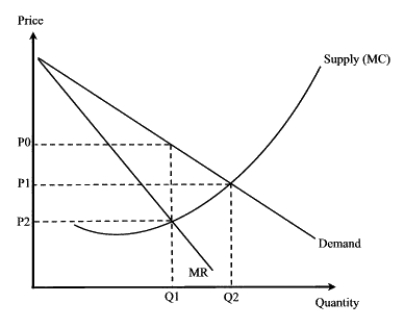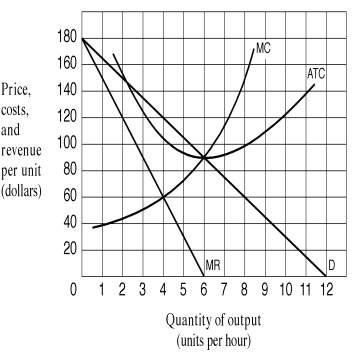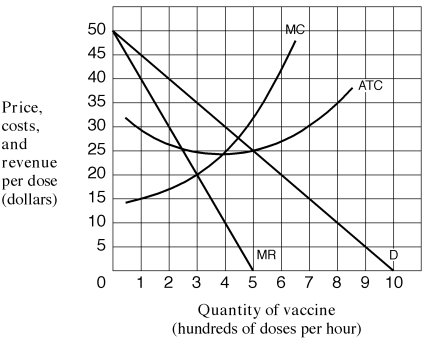A) losses.
B) high prices.
C) potential competitors.
D) taxes.
Correct Answer

verified
Correct Answer
verified
True/False
In order for a monopolist to earn a positive economic profit in short-run equilibrium,price must exceed average total cost.
Correct Answer

verified
Correct Answer
verified
Multiple Choice
Water is often provided to households by one supplier because:
A) there is not enough competition in the market.
B) the single supplier cannot supply the entire market demand at a lower cost than two or more smaller firms could.
C) long-run average total cost increases over the entire range of output.
D) it is a natural monopoly.
Correct Answer

verified
Correct Answer
verified
Multiple Choice
Exhibit 8-7
 -According to Exhibit 8-7,if competition was introduced in a monopoly market,we could expect which of the following to occur?
-According to Exhibit 8-7,if competition was introduced in a monopoly market,we could expect which of the following to occur?
A) Price to fall from P0 to P1 and output to rise from Q1 to Q2.
B) Price to fall from P1 to P2 and output to fall from Q2 to Q1.
C) Price to fall from P0 to P2 and output to fall from Q2 to Q1.
D) Price to rise from P1 to P0 and output to rise from Q1 to Q2.
E) Price to fall from P1 to P0 and output to fall from Q2 to Q1.
Correct Answer

verified
Correct Answer
verified
Multiple Choice
Airlines often charge customers more if they don't stay over at their destination on a Saturday night.The best explanation for this is that the airline is engaging in:
A) predatory pricing.
B) arbitrage.
C) price discrimination.
D) perfect competition.
Correct Answer

verified
Correct Answer
verified
Multiple Choice
When is a monopolist able to charge a lower price than a competitive firm?
A) Never.
B) If the monopolist is a natural monopolist.
C) If the monopolist is able to price discriminate.
D) If the monopolist has enough profit.
Correct Answer

verified
Correct Answer
verified
Multiple Choice
Monopolies misallocate the resources because:
A) a monopoly means less output at lower price.
B) price is equal to the marginal cost.
C) the marginal benefit of the last unit produced is equal to the marginal cost of the last unit.
D) perfect competition means more output for less price.
Correct Answer

verified
Correct Answer
verified
Multiple Choice
If the monopolist can discriminate between buyers,then it is optimal to charge:
A) a higher price to the buyers with high elasticity of demand, and a lower price to the buyers with low elasticity of demand.
B) a lower price to all buyers.
C) a higher price to all buyers.
D) a lower price to the buyers with high elasticity of demand, and a higher price to the buyers with low elasticity of demand.
Correct Answer

verified
Correct Answer
verified
Multiple Choice
Exhibit 8-4 Demand and cost curves for a monopolist
 -As shown in Exhibit 8-4,in order to maximise its profit (or minimise its loss) ,how much output should the monopoly produce?
-As shown in Exhibit 8-4,in order to maximise its profit (or minimise its loss) ,how much output should the monopoly produce?
A) 2 units per hour.
B) 4 units per hour.
C) 6 units per hour.
D) 8 units per hour.
Correct Answer

verified
Correct Answer
verified
Multiple Choice
If the firm owns vital resources,the market is likely to be:
A) a monopoly.
B) an oligopoly.
C) monopolistically competitive.
D) perfectly competitive.
Correct Answer

verified
Correct Answer
verified
Multiple Choice
Given similar market conditions,we would expect a monopolist to:
A) charge a higher price and produce a lower output than under perfect competition.
B) charge a lower price and produce a lower output than under perfect competition.
C) charge a higher price and produce a higher output than under perfect competition.
D) charge the same price and produce the same output as in perfect competition.
E) charge a lower price and produce a higher output than under perfect competition.
Correct Answer

verified
Correct Answer
verified
Multiple Choice
Which of the following statements is true?
A) One reason a monopoly can earn economic profits is because it can raise price and restrict output.
B) A perfectly competitive firm can earn economic profits because it can raise price and restrict output.
C) Income is transferred from producers to consumers in a monopoly compared to perfect competition.
D) Monopolists who price-discriminate rarely earn positive economic profits in the long run.
E) A monopolist misallocates resources because P = MC.
Correct Answer

verified
Correct Answer
verified
Multiple Choice
The act of buying a commodity in one market at a lower price and selling it in another market at a higher price is known as:
A) buying long.
B) selling short.
C) a tariff.
D) arbitrage.
Correct Answer

verified
Correct Answer
verified
Multiple Choice
Exhibit 8-3 Demand and cost curves for GeneTech, a monopolist with a patented vaccine
 -As shown in Exhibit 8-3,in order to maximise its profit,what price should GeneTech charge for its vaccine?
-As shown in Exhibit 8-3,in order to maximise its profit,what price should GeneTech charge for its vaccine?
A) $20 per dose.
B) $25 per dose.
C) $35 per dose
D) $50 per dose.
Correct Answer

verified
Correct Answer
verified
Multiple Choice
What is the major difference between perfect competition and monopoly?
A) The slope of the supply curve faced by the firm.
B) The slope of the demand curve faced by the industry.
C) The slope of the supply curve faced by the industry.
D) The slope of the demand curve faced by the firm.
Correct Answer

verified
Correct Answer
verified
Multiple Choice
A price-discriminating monopoly charges the lowest price to the group that:
A) has the most elastic demand.
B) purchases the largest quantity.
C) engages in the most arbitrage.
D) is least responsive to price changes.
Correct Answer

verified
Correct Answer
verified
Multiple Choice
A monopolist that lowers its price and increases output,even at the expense of short-run profits,is engaging in:
A) predatory pricing.
B) price discrimination.
C) predatory discrimination.
D) multi-purpose pricing.
E) a flexible pricing strategy.
Correct Answer

verified
Correct Answer
verified
Multiple Choice
A natural monopoly occurs because:
A) of the lack of competition.
B) of ownership of vital resources.
C) its long-run average cost of production declines throughout the entire range of output.
D) of the patent.
Correct Answer

verified
Correct Answer
verified
Multiple Choice
A monopolist can engage in price discrimination:
A) if it faces a perfectly elastic demand curve.
B) if it is able to buy a good at a low price and resell it at a higher price.
C) if it is a price maker, can segment the market and prevent customers from reselling.
D) if it faces a perfectly inelastic demand curve.
Correct Answer

verified
Correct Answer
verified
Multiple Choice
Exhibit 8-7
 -According to Exhibit 8-7,the price a monopolist would charge is:
-According to Exhibit 8-7,the price a monopolist would charge is:
A) P0.
B) P1.
C) P2.
D) indeterminate as there is not enough information provided.
Correct Answer

verified
Correct Answer
verified
Showing 21 - 40 of 123
Related Exams